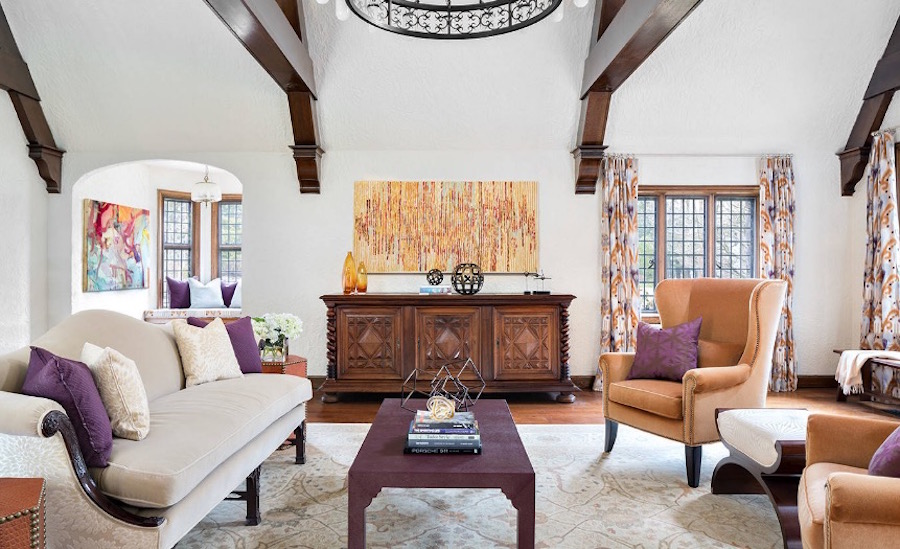
19 Jul What to Look for When Shopping for Accessories

A few tips can make shopping for accessories much easier. Image: Studio Duggan Ltd.
If you’ve been an interior design aficianado for any length of time, you know that including the right accessories can make or break a room. However, beyond giving that initial piece of advice, most design sites are vague in terms of how to find the decorative items that will complete your design. That confusion stops here.
If you’ve been wondering how to find decorative items that work, you’re in luck. We developed a guide on shopping for accessories. Use our tips to help gain clarity before your next spending spree. That way, you can be sure you’re purchasing pieces that take your design to the next level.

Many décor elements can be considered accessories. Image: Arkee Creative
Know your options
Before you can start shopping for accessories, it’s helpful to know what to look for. In truth, this is a broad category, so it can be hard to pin down. We like to think of it this way: An accessory is anything that adds aesthetic value to the room. It can also serve a functional purpose, but it doesn’t have to.
With that definition in mind, here are some common examples:
Area rugsThrow pillows and blanketsWall art and mirrorsDecorative bowls and traysCoffee table booksCandlesPicture framesFlowers and vasesDécor items
As you embark on your shopping trip, keep items like these in mind. That said, this is by no means an exhaustive list. Feel free to think outside the box. Odds are, any item you think will add aesthetic value to the room will pass the accessory test with flying colors.

Each room should have a statement piece. Image: Minhnuyet Hardy Interiors
Pick a statement piece
If there’s one key rule for accessories, it’s that every room needs a statement piece. This is a singular item that is big and bold and will unquestionably draw the eye. Think of this piece as the backbone of your décor. Everything else, accessory-wise, is built around it.
Ideally, your statement piece highlights the focal point of the room, so do your best to think about applications that fit well into the space. Wall art is always a good choice, as are decorative mirrors or even a large lighting fixture. Whichever you choose, finding a piece with the correct measurements is paramount. Be sure to choose something that is proportionately in line with the room’s main feature.
As far as aesthetics are concerned, this is the time to push the limits. While you want your statement piece to mesh well with your design, it also needs to stand out. There should be no question which accessory is the statement piece, after all.

Keep your colors consistent. Image: Clean Design
Consider the color palette
Once you have a statement piece in place, use that to build the rest of your color scheme. Odds are, the rest of the room — meaning the wall coverings and furniture — may end up being fairly neutral, so your accessories are the time to add visual interest.
As always, you want to consider the 10-30-60 rule. In this case, concentrate on the 10 and 30 segments. As you shop, look for elements that easily bring a secondary (slightly bold) and accent (eye-catching) color into the space. Of course, you also want to make sure both colors go well together and work in harmony with your dominant neutral shade.
In addition to color, you may also want to add some prints and patterns to the room through your accessories. Keep in mind that not every piece you purchase should include a bold design. However, choosing one or two can add a lot of visual interest.

Vary sizes to add visual interest. Image: Home Ingredients
Vary shape and size
Color is far from the only element that can be used to make a room more interesting. Where accessories are concerned, you can a make a big impact by varying two details: shape and size.
This advice can be applied to nearly all the items on our accessories list. Though rugs should be in proper proportion to the room, pillows can come in a variety of sizes. Books can be stacked. Plus, décor items can come in nearly any arrangement under the sun.
To take your accessories to the next level, focus on purchasing pieces that can eventually be put together into groupings. These pieces work best when they’re purposely arranged together, rather than standing on their own.

Use our tips the next time you find yourself shopping for accessories. Image: Dalia Canora Design LLC
Shopping for accessories is no easy task. On the one hand, the category itself feels a little vague, even for design experts. On the other, it’s extremely important to pick items that elevate your design, yet feel cohesive with one and other. If you need help tackling this task, the tips in the guide can help you shop for accessories that check all the boxes.
Do you like shopping for accessories? Do you have any tips to share on how to pick the perfect items to complete a design? Share your thoughts in the comments.
The post What to Look for When Shopping for Accessories appeared first on Freshome.com.
Read more: feedproxy.google.com

